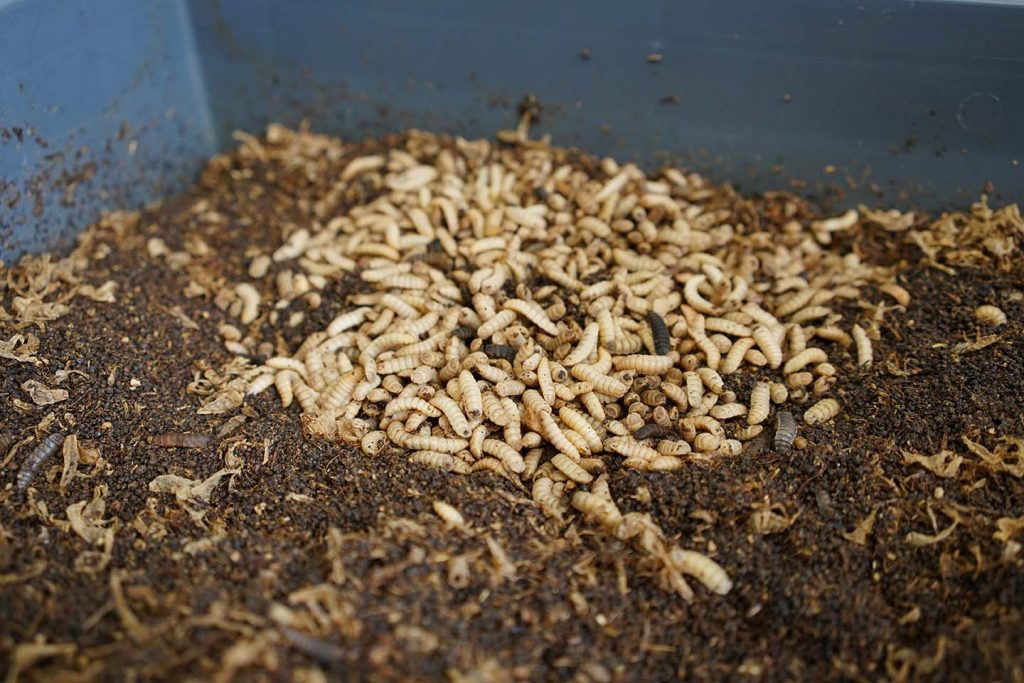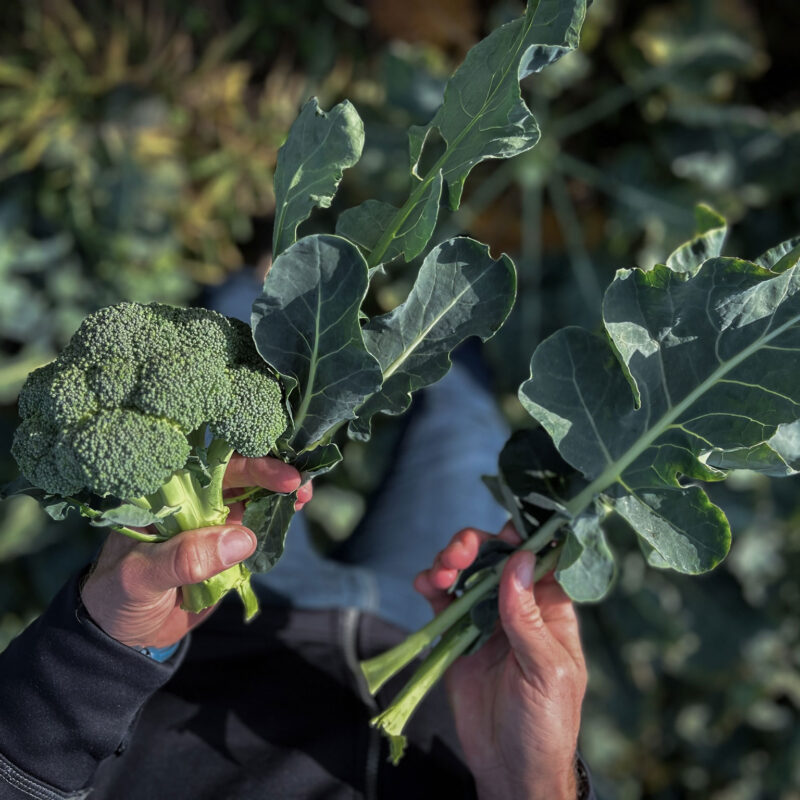5 Tons of Green Fish on the Plate – Circular-Based Feed Via Insects
What started with the basic concept of “Our food should preferably not be eating our food” resulted in an infrastructure converting vegetable-based waste streams into a high-protein feedstock for farmed fish. Between 2018-2022, Axfoundation carried out the project “Five Tons of Green Fish” in collaboration with the Swedish University of Agricultural Sciences (SLU) and actors from every step of the food chain. The project resulted in Sweden’s first green rainbow trout fed with a circular-based fish feed of mainly insects which, in turn, have been raised on a diet of food waste.

The world's commercial fish stocks are depleted. Tons of food is thrown away each year. Meanwhile, farmed fish are often fed with imported wild-caught fish and soybeans.
The Issue
While the global population is increasing, so too is our consumption of blue food. Meanwhile, 90% of the world’s commercial fish stocks are depleted or overexploited. Farmed fish is often seen as an opportunity to provide people with food without increasing pressure on the world’s oceans. Today, about half of all blue food in the global market is farmed, but this is also not without challenges. Farmed fish is raised on feed that mainly consists of soybeans and wild-caught fish, often from different parts of the world. These are foods that could be eaten by humans without first taking a detour through fish. Global fish farming, therefore, contributes negatively to the global food supply.
Our food should (preferably) not eat our food.
– Madeleine Linins Mörner, Programme Director Future Food, Axfoundation
1.3 million tons of food waste annually
Today’s food systems also have major issues with food waste and the reuptake of nutrients. Sweden imports cheap nutrition in the form of food, feed and fertilizers. Additionally, 1.3 million tons of food is thrown away annually from food manufacturers, shops, restaurants, and households in Sweden. Today, food waste is often used in ways that are not resource efficient. As much as 40% goes into making biogas and biofertilizer for fields, the rest is used for heating and electricity production. This linear food system contributes to unnecessary greenhouse gas emissions and also risks that nutrients leak into the Baltic Sea and contribute to the eutrophication problem.
Our Solution
The project Five Tons of Green Fish has proven that it is possible to grow an environmentally friendly and tasty Swedish fish on a large scale, while at the same time making use of an unused raw material resource; food waste from industry. The result is Sweden’s first green rainbow trout.
Instead of imported soybeans and imported wild-caught fish, the green rainbow trout were raised on a circular-based fish feed that consisted of raw materials almost exclusively produced in Sweden, and that are not very attractive for human consumption. A key ingredient was insects – fed with organic waste in the form of vegetable peel and bread scraps from the food industry, waste that would otherwise have been discarded.
Other ingredients in the feed were farmed mussels and sea urchins that have been eating phytoplankton. These ingredients extract nutrients from the sea, thereby contributing to reduced eutrophication.
Circular-Based Feed
The circular-based feed consisted of raw materials that are almost exclusively produced in Sweden, and that are not very attractive for human consumption:
- Insects (larvae from black soldier flies and mealworm) raised on food waste.
- Swedish rapeseed oil.
- Fishmeal and fish oil from MSC-certified Baltic sprat that cannot be sold for human consumption, but is purified to remove PCBs and dioxins and retain food quality.
- Swedish wheat.
- Farmed mussels and sea urchins that have reduced eutrophication during their growth and purified the water around them by eating phytoplankton and converting them to protein.
- A concentrate from broad beans, a plant that’s useful in the crop rotation to improve the quality of arable land.

Organic waste in the form of shells, kernels and bread remains became food for insects, which in turn was processed into fish feed.

Unlike conventionally farmed fish, the Swedish green rainbow trout was bred on a circular-based feed that consisted of raw materials that are not attractive for human consumption.
Our Work
The project was run by Axfoundation and the Swedish University of Agricultural Sciences (SLU) from 2018 to 2022. In collaboration with actors from across the entire production and distribution chains, we built an infrastructure to convert vegetable residues into a quality raw protein material that can be used in animal feed.
The Project’s Four Main Objectives:
- To produce a circular-based feed, without adding any unwanted nutrients to the Baltic Sea’s drainage basin.
- To produce at least five tons of Swedish environmentally friendly fish of high gastronomic quality.
- To support the development of circular-based feed materials.
- To support Swedish municipalities’ environmental work as part of circular food production.
Results
In total, the project produced 4,5 tons of green rainbow trout of high gastronomic quality, which was sold to consumers and to restaurants. The rainbow trout was farmed by Älvdalslax in an open aquaculture site, carefully selected as the location has water that requires more nutrients, which is exactly what fish farming helps with. An evaluation of the circular-based feed indicated that the fish grows just as well, if not better, than the reference fish that was fed with a conventional feed. According to a taste evaluation carried out by some of Sweden’s top chefs, the rainbow trout tasted more like wild-caught fish than the reference fish that was fed with conventional feed.
Circular feed price can match conventional feed
The price on the circular-based feed during the fall of 2021 was 23 SEK/kg, compared to the price on the conventional feed which was 14-15 SEK/kg. The price calculations, however, were done before the war in Ukraine and during 2022, the price on conventional feed had increased by 35%, to around 19 SEK/kg. According to the project’s business modelling, the locally produced circular feed would not be affected by the global events to the same extent. When considering the planned investments from the industry, the circular-based feed will in time reach the same market price as the conventional feed.
Feed with up to 70% lower emissions
As a final result of the project, a life cycle analysis from Mistra Food Futures showed a decrease in greenhouse gas emissions by 70% compared to conventional fish feed. Based on data from SINTEF, the climate impact is 30% lower than regular feed used for farmed Norwegian salmon. The next step is to develop circular insect-based feed for pigs, laying hens, and broilers as well as facilitate a continuous production of the green rainbow trout. In December 2022, financing was approved for such a project.

The rainbow trout went on sale from November 2021 in selected Hemköp stores and at Urban Deli, Fotografiska, TAK and Compass Group restaurants in Stockholm.
Obstacles to Scaling Up
Through the project, parts of the infrastructure and knowledge needed are in place to enable further scale-up and replace unsustainable feed raw materials for more animal species. However, several obstacles need to be addressed to go from pilot to scale.
- Legislation is lagging behind
All food waste must be available for use in feed production, not only waste from plants but also household and restaurant waste from several food sources. The legislation for this is, however, lagging behind at both the national and EU level in terms of which residual resources may be used, making the process more difficult and expensive. - Circular transitions
The Government should gather authorities, businesses, and academia around the same table. To match one actor’s waste with another actor’s needs for inputs, businesses need to cooperate across industries and sectors. - Lack of consensus and a lack of circular mapping
In today’s linear food system, a number of unused resources are not returned to the food chain or are used inadequately. These issues could be rectified through fully circular systems. There is also a lack of mapping as to what the resource flows in the industry are and how they could be used. - Linear food systems are too cheap
Today, it is costly for individual food producers and feed producers to break from linear systems and find circular solutions of their own. - Business and politics need to collaborate
To support the transition to increased fish farming with sustainable feed, permit processes need to be facilitated and investment support is required to build up domestic feed production. - Set requirements for sustainable fish in shops and restaurants
Buyers as well as consumers can contribute to more sustainable fishing and aquaculture by making informed choices when purchasing fish and shellfish, such as choosing green-listed ASC or KRAV-certified products from the local area.
Partners
The project was led by Axfoundation and the Swedish University of Agricultural Sciences (SLU). Partners that collaborated on this project included: Axfood, Eskilstuna Strängnäs Energi och Miljö, Fazer, Fiskhallen Sorunda, Grönsakshallen Sorunda, Härnösand Energi & Miljö, Lantmännen, Marine Feed, Raisio, Restaurang- och hotellhögskolan Grythyttan vid Örebro universitet, RISE, Sweco, Tebrito, Vattenbrukscentrum Norr AB och Älvdalslax.
The project also included several associated partners, such as five land-based fish farms (Aquaagro, BIO Ras Ljusdal, Gårdsfisk, Peckas Naturodling och Smögenlax), the Aquaculture Stewardship Council, he Beijer Institute, the Swedish Board of Agriculture’s Aquaculture Office, Matfiskodlarna and the National Competence Centre for Aquaculture.
The project was partly funded by Sweden’s innovation agency, Vinnova, and made possible thanks to a close collaboration with the Swedish Cyclical Feed project, which was funded by the Kamprad Family Foundation for Entrepreneurship, Research & Charity.

























































